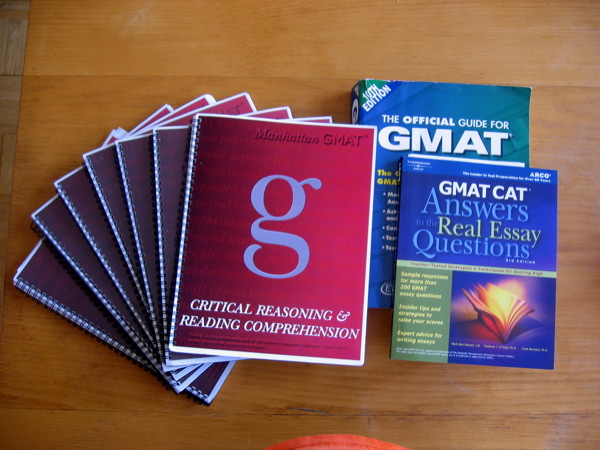
GMAT vs. GRE: Understanding MBA Admission Tests
Students interested in pursuing an MBA will face an important decision: whether to take the GMAT vs. GRE. The Graduate Management Admission Test (GMAT) and the Graduate Record Examinations (GRE) are both types of standardized tests used to evaluate applicants for postgraduate education programs. As such, many top MBA programs require applicants to take either the GMAT or GRE to be considered for admission. Therefore, it’s logical that many MBA applicants look for a clear answer to the question, what is the difference between the GMAT and GRE?
Forming your own opinion of the GMAT vs. GRE requires understanding their similarities and differences. Making this decision is crucial for any student planning on applying for an MBA, or any other graduate program. Before jumping into a GRE or GMAT practice test, you’ll want to get a sense of each test and what they offer. Once you are more familiar with the GMAT vs. GRE, you can feel confident making an informed decision about which test is best for you.
In this article on the GMAT vs GRE for MBA, we’ll discuss the distinct characteristics of each test you’ll want to consider when deciding between the GMAT vs. GRE.
You’ll find answers to questions such as:
- What is the difference between the GMAT vs. GRE?
- How much are GRE vs. GMAT exam fees?
- What is a good GMAT score?
- What is a good GRE score?
- Is it better to take the GMAT vs. GRE?
- How do I prepare for the GMAT vs. GRE, and more!
To start, we’ll take a closer look at each of these business school tests. First, we’ll go over the Graduate Management Admission test. Then, we’ll go over the Graduate Record Examinations. Later, we’ll discuss GMAT vs GRE difficulty and why you might choose to take the GMAT vs GRE for MBA applications.
Before we start exploring the differences between the GMAT vs. GRE, let’s look at these tests in context. In the next section, you’ll find a brief overview of common MBA application requirements and how MBA tests factor into them.
MBA Application and Testing Requirements

When looking at the GMAT vs. GRE, it’s important to understand both are reputable MBA tests used to gain admission to top business programs. However, these tests constitute just one element of the MBA application requirements you’re likely to encounter. When applying to MBA programs, you can expect to encounter the following MBA requirements:
- College transcripts
- Resume
- Application essay
- Letter(s) of recommendation
- Interview
- and, of course, GMAT/GRE scores!
You’ll encounter these common application elements no matter if you’re looking at the Wharton MBA requirements or the USC MBA program requirements. And, they apply to various types of MBA programs, including both full-time and executive programs.
Your GMAT/GRE scores play a crucial role in the application process. These standardized tests demonstrate how prepared you are to be successful in a rigorous graduate program. Regardless of whether you decide to take the GMAT vs. GRE, a strong score is crucial to stand out against other competitive applicants. Therefore, mastering either the GRE or GMAT is crucial to meeting MBA admission requirements.
Confirming MBA Application Requirements
Before you make a decision between the GMAT vs GRE for MBA admissions, it’s important to confirm which MBA test your program accepts. While many MBA requirements include both tests, some MBA requirements only include the GMAT.
Let’s look at some top programs to see which tests they accept as part of their MBA application requirements:
- Harvard MBA requirements: Accepts both the GMAT and GRE.
- Stanford MBA requirements: Accepts both the GMAT and GRE.
- Wharton MBA requirements: Accepts both the GMAT and GRE.
- USC MBA Program Requirements: Accepts both the GMAT and GRE.
As you can see from the above examples, many top programs accept both the GMAT and GRE. However, be sure to check the requirements at the schools you are interested in
Remember, having a strong GMAT or GRE score can significantly improve your chances of being accepted into the graduate program of your choice. Consequently, choosing between the GMAT vs. GRE is an important decision. But how do you know if the GMAT vs. GRE is better for you?
Well, before we can start making comparisons between the GMAT vs. GRE, we need to start by understanding just what they are. In the following sections, we’ll define both the GMAT and GRE and discuss what to expect from each test in terms of structure, difficulty, and scoring.
What is the GMAT?
The GMAT, or Graduate Management Admission Test, is the most popular standardized test used to gain entry to MBA programs. When considering the GMAT vs. GRE, it’s important to note the GMAT was created specifically for business schools to assess the skills and potential of their applicants. So, many people consider the GMAT to be “the” business school test.
The GMAT tests for proficiency in business-related skills, including reading comprehension, evaluating arguments, data analysis and interpretation, and data-driven decision-making. GMAT exam fees depend on the country in which you are testing. In the U.S., GMAT exam fees range from $275-$300. The GMAT exam fees are $275 if you take the test in person at a testing center and $300 if you take the test online. Make sure to take note of the slight cost difference when considering which test-taking environment is right for you.
Is the GMAT multiple-choice?
Yes, if you take a GMAT practice test, you’ll find that the Graduate Management Admission Test is multiple-choice. Some examples of question formats include table analysis, graphics interpretation, and multi-source reasoning. The latest version of the test does not include a writing section, which brings us to…
New GMAT Structure
When considering the GMAT vs. GRE, it’s important to discuss the most up-to-date versions of each test. If you research various MBA application requirements, you may find notices about a new version of the Graduate Management Admission test. As of February 1st, students interested in taking the GMAT will be required to take the updated GMAT Focus Edition.
The new GMAT is 2 hours and 15 minutes long. The GMAT structure of the Focus Edition is as follows:
- Quantitative Reasoning: 21 questions (45 minutes)
- Verbal Reasoning: 23 questions (45 minutes)
- Data Insights: 20 questions (45 minutes)
The main difference between the old and new tests is the updated GMAT structure. The old GMAT was over 3 hours long, whereas the new GMAT is nearly an hour shorter. The new GMAT has no analytical writing assessment, meaning students will not need to do any writing as part of the new test. Additionally, students can choose which order they’d like to complete the sections in.
Perhaps the most significant change is the question review and editing feature of the new GMAT. Previously, students could not go back to revise answers once they’d moved on from a question. With the new test, students now have the option to review their answers and even change up to three per section.
Is the GMAT difficult?

While each student will have their own experience, when discussing the GMAT vs GRE in terms of difficulty, the GMAT is considered an extremely challenging test. Most students, no matter how smart or capable they are, will be challenged by their first GMAT practice test. The GMAT structure, types of questions, and time constraints make the test challenging for anyone who hasn’t specifically prepared for it.
Additionally, the GMAT is a Computer Adaptive Test. That means the difficulty of the test is determined in real time relative to the test taker’s abilities. Essentially, the more questions you get right, the harder the test becomes.
Familiarizing yourself with the concepts and types of questions included in the GMAT is key to overcoming its challenging nature. Beyond studying the concepts, you’ll want to prepare for the test-taking setting. That means taking GMAT practice tests and practicing within the time constraints laid out in the GMAT structure.
Up next, we’ll discuss the answer to another common GMAT vs. GRE question: what is a good GMAT score?
What is a good GMAT score?
Now, just what is a good GMAT score? To determine what is a good GMAT score, you first need to understand the scoring system of the GMAT. GMAT scores for the new Focus Edition can fall between 205 and 805, with 805 being the highest score possible.
The answer to the question, “What is a good GMAT score?”, will generally depend on the specific program you are applying to. Most schools do not have score requirements as part of their MBA application process. That means you won’t find minimum GMAT scores included in the Harvard MBA requirements, Stanford MBA requirements, or MBA requirements at other top programs.
However, many MBA programs provide statistics from their most recently admitted MBA classes. The scoring system for the new GMAT is slightly different than the old GMAT. Here are some average GMAT scores to consider.
Average GMAT scores
| MBA program | Average GMAT scores of Admitted Students |
| Harvard Business School | 740 |
| Stanford Graduate School of Business | 738 |
| The Wharton School of the University of Pennsylvania | 728 |
| USC Marshall School of Business | 722 |
As you can see, answering the question “what is a good GMAT score at Harvard and Stanford?” will incite fairly similar responses. Additionally, a good GMAT score at Wharton and USC aren’t far behind. In fact, all applicants’ average scores at these top schools fall within a less than 20-point range. But don’t worry if your initial score on your first GMAT practice test isn’t in this range – we’ll discuss how to prepare for the GMAT vs. GRE later in this guide.
Now that we have a sense of what is a good GMAT score, let’s discuss the second type of business school test. Remember, when applying to business school, students generally have a choice between taking the GMAT vs. GRE. If the GMAT doesn’t seem like the right fit, you might consider taking an alternative test to satisfy your MBA application requirements: the GRE.
What is the GRE?

The GRE, or Graduate Record Examinations, is the most widely used graduate admissions test. Although it is used to apply to a variety of graduate programs, the GRE is becoming increasingly popular in MBA admissions. According to the Educational Testing Service, which administers the GRE, over 1,300 business programs worldwide accept GRE test scores. Additionally, schools that accept both tests do not share a personal preference between the GMAT vs. GRE, so the decision is ultimately yours.
When comparing the GMAT vs. GRE, both tests evaluate students on similar subjects and abilities. The GRE tests for proficiency in a variety of skills including analyzing and drawing conclusions from both data and discourse, understanding quantitative information, and forming and effectively articulating ideas and arguments. It costs $220 to take the GRE. The cost is the same whether you choose to take the test in person at a testing center or at home. So, you do not need to factor in cost differences when choosing a testing environment.
Is the GRE multiple-choice?
Yes, the GRE structure is primarily multiple-choice. Questions on the Graduate Record Examinations may include quantitative comparison, numeric entry, text completion, and reading comprehension questions.
However, there’s another important question to ask yourself when comparing the GMAT vs. GRE: do you want to complete a writing section? In addition to multiple-choice questions, the GRE includes an analytical writing assessment. This section requires students to craft a written response in which they discuss an issue and construct a supported argument. And, as it so happens, when considering the GMAT vs. GRE, there is also a new version of the GRE to be aware of…
New GRE structure
Similar to the GMAT, the updated GRE is shorter than its predecessor. As of September 2023, students can take a new, shortened GRE to fulfill their MBA application requirements. This version of the GRE is 1 hour and 58 minutes long. The new GRE structure is as follows:
- Analytical Writing:
- 1 writing task (30 minutes)
- Verbal Reasoning:
- Section 1 – 12 questions (18 minutes)
- Section 2 – 15 questions (23 minutes)
- Quantitative Reasoning:
- Section 1 – 12 questions (21 minutes)
- Section 2 – 15 questions (26 minutes)
Let’s compare the GRE structure of the new test vs. the old test. Compared to the older GRE, the new test is 1 hour and 47 minutes shorter. The new test features only one Analytical Writing task (the older version had two) and does not include an additional unscored section.
The GRE has always given students the option to go back and review their answers, making changes as needed throughout a section. However, it’s important to note that once you complete a section, you cannot go back and revise your answers. Unlike the GMAT, you are allowed to use an on-screen calculator to help you answer questions in the Quantitative Reasoning sections.
Is the GRE difficult?
Although the GRE is sometimes referred to as the “easier” test when discussing GMAT vs GRE difficulty, don’t be fooled. It is just as challenging a test as the GMAT. Compared to the older GRE, you might find the newer, shorter version easier in terms of staying focused. However, even though there are fewer questions, you’ll still encounter the same challenging content as you would on the longer GRE.
Just like the GMAT, the GRE is also a Computer Adaptive Test. However, the GRE’s adaptive nature is section-based (versus question-based, like the GMAT). That means your performance on the first Verbal and Quantitative sections will determine the difficulty of the second Verbal and Quantitative sections.
One thing that does not change regardless of GMAT vs. GRE is the importance of preparation. Preparing for the GRE is crucial to earning a competitive score. Especially without the unscored section, every question you answer will directly impact your score. So, be sure to use updated GRE practice tests corresponding to the new, shorter version when studying for the exam.
What is a good GRE score?

The answer to “what is a good GRE score?” looks a little different than it does for the GMAT. When considering the question of what is a good GRE score, you’ll need to consider that the GRE has three separate sections: Verbal Reasoning, Quantitative Reasoning, and Analytical Writing. So, what is a good GRE score for each section? The GRE is graded on a scale between 130-170 possible points for both the Verbal and Quantitative Reasoning sections. The Analytical Writing section is graded on a scale of 0-6 possible points.
When considering what is a good GRE score, you’ll want to focus mainly on the Verbal and Quantitative Reasoning sections. This is because most MBA programs will focus primarily on your V/Q scores. As such, those are the ones you’ll find reported in their recent class statistics.
As with the GMAT, MBA requirements for top programs, including the Harvard MBA requirements, Stanford MBA requirements, Wharton MBA requirements, and USC MBA program requirements, don’t have minimum scores. However, you can still compare each school’s reported average scores to help you get a sense of what is a good GRE score:
| MBA program | Average GRE scores of Admitted Students |
| Harvard Business School | Verbal – 163, Quantitative – 163 |
| Stanford Graduate School of Business | Verbal – 164, Quantitative – 164 |
| The Wharton School of the University of Pennsylvania | Verbal – 162, Quantitative – 162 |
| USC Marshall School of Business | Verbal – 160, Quantitative – 163 |
As you can see, average GRE scores are similar across these top MBA programs. Note that these scores are from students who took the longer version of the GRE. That being said, both versions of the test use the same score chart, so these GRE scores are still a good benchmark for students taking the updated GRE.
Now that we’ve discussed both what is a good GRE score and GMAT score, let’s do some more comparison of the GMAT vs. GRE.
Comparing GMAT vs. GRE for MBA

Deciding between the GMAT vs. GRE for your MBA test is an important, and individual, decision. You might have questions, such as “is the GMAT harder than the GRE?” and “should I take the GMAT vs GRE for MBA applications?” And you might still be wondering how the GMAT vs GRE difficulties compare to one another. While the answers to these questions are complex and personal, there are some similarities and differences that can help you make your own decision about the GMAT vs. GRE.
When looking at a GRE or GMAT practice test, you might think the tests look pretty similar. They both are comprised of multiple-choice questions, have Quantitative and Verbal Reasoning sections, and take about two hours to complete. In terms of GMAT vs GRE difficulty, both tests are known to be challenging and will require preparation to achieve a strong score.
Most programs don’t have a preference between GMAT vs GRE for MBA admissions. However, while some view the GMAT vs. GRE as interchangeable, they are certainly different tests. With that in mind, let’s take a look at a side-by-side comparison of these MBA tests.
GMAT vs. GRE Comparison
| GMAT: Graduate Management Admission Test | GRE: Graduate Record Examinations | |
| Structure | The GMAT structure consists of 3 sections: • Quantitative Reasoning • Verbal Reasoning • Data Insights Students will answer 64 questions in total (Quant-21Q, Verbal-23Q, Data Insights-20Q). There is no additional analytical writing assessment. | The GRE structure consists of 5 sections: • Quantitative Reasoning I / II • Verbal Reasoning I / II • Analytical Writing Students will answer 54 questions in total (Quant-27, Verbal-27Q) and complete 1 analytical writing assessment. Quantitative and Verbal Reasoning are each split into two separate sections. |
| Format | Multiple-choice questions | Multiple-choice questions, written response |
| Length | The GMAT is 2 hours, 15 minutes: • Quant (45 minutes) • Verbal (45 minutes) • Data Insights (45 minutes) | The GRE is 1 hour, 58 minutes: • Quant (Section 1:-21 minutes, Section 2-26 minutes) • Verbal (Section 1-18 minutes, Section 2-23 minutes) • Analytical Writing (30 minutes) |
| Unique Exam Features | • Ability to bookmark questions for review. • Ability to change up to three answers per section. • Ability to choose what order to complete the sections in. | • Ability to bookmark questions for review. • Ability to change answers as many times as necessary, within the time limit for each section. • Ability to use a calculator for the Quantitative Reasoning sections. |
| Scoring | One overall/composite score ranging from 205-805 | Three overall section scores: • Quant: 130-170 • Verbal: 130-170 • Analytical Writing: 0-6 |
| Cost (if taking in the U.S.) | GMAT exam fees: • In-person: $275 • Online: $300 | GRE exam fees: • In-person: $220 • Online: $220 |
As you can see, there are important differences to note between the GMAT vs. GRE. For example, GMAT exam fees are slightly different depending on your testing environment. However, the GRE exam fees are the same whether taking the test in person or online. There are also key differences between the GMAT structure vs. the GRE structure in terms of sections and overall questions asked.
In the next section, we’ll highlight some of the most important differences to consider when comparing the GMAT vs. GRE as MBA tests.
5 Differences between GMAT and GRE
So, just what is the difference between the GMAT and GRE? Here are 5 key differences to keep in mind when deciding between the GMAT vs. GRE for your postgraduate education applications:
5 Differences between the GMAT and GRE
1. Format
Both tests are primarily multiple-choice. However, the GMAT structure is different from that of the GRE. While both tests have Verbal and Quantitative Reasoning sections, each has a unique third section. The GRE has an analytical writing assessment, whereas the GMAT has another multiple-choice section called Data Insights.
2. Length
The new GMAT is longer than the new GRE. The GMAT is split into three, 45-minute sections. Overall, the GMAT takes 2 hours and 15 minutes to complete. The GRE is split into five sections, each 18-30 minutes long. Overall, the GRE takes 1 hour and 58 minutes to complete.
3. Scoring
Thanks to the differences in the GMAT vs. GRE structure, the answers to “what is a good GMAT score?” and “what is a good GRE score?” are different. The GMAT provides one overall score ranging from 205-805. The GRE provides scores for each section, ranking from 0-6 in Analytical Writing and 130-170 in Quantitative/Verbal Reasoning.
4. Focus
The GMAT vs. GRE have different practical applications and therefore different focuses. The GMAT is business school-specific, whereas the GRE is applicable to all graduate programs. Although the focuses are slightly different, both exams test similar concepts and skills.
5. Adaptiveness
Although both of these MBA tests are computer-adaptive, the GMAT is question-adaptive while the GRE is section-adaptive. When looking at the GRE structure, this means the computer will evaluate your performance on the first Quantitative/Verbal Reasoning sections to determine the difficulty of the questions provided for the second Quantitative/Verbal Reasoning sections. The GMAT adapts in real-time, not according to individual section performance.
Now that we’ve covered some key differences between the GMAT vs. GRE, let’s discuss one of the most widely debated GMAT vs. GRE topics: difficulty. Then, we’ll discuss the pros and cons of the GMAT vs. GRE, as well as how to factor these aspects into your final decision.
Is the GMAT harder than the GRE?
When debating whether to take the GMAT vs GRE for MBA, one of the biggest questions is always which test is harder. The GMAT vs GRE difficulty depends on your individual strengths as a student and test-taker. In terms of GMAT vs GRE difficulty, the verbal section of the GRE structure is often considered more challenging. On the other hand, the quantitative section of the GMAT structure is considered more challenging.
Ultimately, for GMAT vs. GRE, you’ll want to choose the test where you will perform your best. Assess your skills, preferences, and the specific MBA test requirements of your dream MBA programs. Then, make the decision that best suits your particular needs.
Choosing the best test for you

At this point, we’ve done a lot to answer the question of what is the difference between the GMAT and GRE. We’ve discussed what is a good GMAT score and what is a good GRE score. And we’ve provided important information about each test, including what to expect from GRE and GMAT exam fees. In the following sections, let’s go more in-depth on how to decide between the GMAT vs. GRE.
Take practice tests
Taking a GRE and GMAT practice test is the best way to assess your strengths and weaknesses on GMAT vs. GRE. This will help you determine your own unique perspective on GMAT vs GRE difficulty. For example, the GMAT structure focuses more on quantitative reasoning, while the GRE is more focused on verbal reasoning. Analyze the sections that you feel more confident in and those you need more practice with. Rather than focusing on the higher initial score, choose the test, GMAT vs. GRE, that will showcase your strengths.
Consider the cost
Another factor beyond GMAT vs GRE difficulty to consider when choosing between GMAT vs. GRE are the GRE and GMAT exam fees. Be prepared to pay $205 to take the GRE or meet the slightly higher GMAT exam fees of $275. Keep in mind, you may also have to pay more GRE and GMAT exam fees for enhanced or additional score reports to send to all of the programs on your list.
Earlier, we answered the questions of what is a good GMAT score and what is a good GRE score. However, you may be wondering if each score holds the same weight in MBA admissions. In the next sections, we’ll explore why you might choose the GMAT vs GRE for MBA.
Is it better to take GMAT or GRE for MBA?

When deciding whether to take the GMAT vs. GRE for your MBA applications, remember that neither test is inherently “better” than the other. Both MBA tests are widely accepted by many MBA programs. The most important consideration is whether one test, GMAT vs. GRE, may be better for you.
In general, when choosing between GMAT vs. GRE, consider the preferences of the schools you’re applying to, your personal strengths, and the score ranges of admitted students. (Which you can discover by researching what is a good GMAT score and what is a good GRE score for a particular school.) Some programs’ curriculums may be more quant-heavy, in which case the Graduate Management Admission Test is the way to go. Other programs may emphasize verbal reasoning, requiring skills that are best demonstrated by taking the GRE.
Research specific schools
If you need to make more concrete comparisons, research what is a good GMAT score and what is a good GRE score for the schools you are interested in attending. Many schools publish their student profile data on their websites for your convenience. Knowing the answer to what is a good GMAT score and what is a good GRE score can help you set your target score and give you a good idea of where you stand in the applicant pool. It can also aid in your decision between GMAT vs GRE for MBA if you feel one average score is more attainable than another.
In the end, the decision between the GMAT vs. GRE should be based on individual strengths, program preferences, the type of MBA you want to pursue, and your future career goals. Take time to consider the GRE and GMAT exam fees before committing to either test. While the Graduate Management Admission Test is more popular in MBA admissions, a high score on either test will enhance your MBA application. Plan on taking a GRE and GMAT practice test to see where you are at and determine the GMAT vs GRE difficulty for yourself!
For those looking for further details to support their choice between GMAT vs. GRE, let’s discuss the unique benefits of the GMAT vs. GRE.
Benefits of taking the GMAT
The Graduate Management Admission Test is used specifically for admission to MBA programs. Because the GMAT largely focuses on analytical skills and quantitative reasoning, students who excel in these areas may find the GMAT vs. GRE to be a good fit for showcasing their strengths to the MBA programs on their list.
Another benefit of taking the GMAT vs. GRE is flexibility. For students interested in attending MBA programs, the GMAT is the more widely accepted test. This opens a broader range of options for admission to MBA programs compared to the GRE, which might not be accepted by some business schools.
The GMAT structure allows you to bookmark questions you are unsure of and change some of your answers. This feature can be advantageous for test-takers who like to come back to questions they are unsure of. Additionally, the GMAT is an adaptive test, so the exam’s difficulty adapts to your level of ability as you take it.
Benefits of taking the GRE
The GRE is widely accepted for admission to various postgraduate educations, not just MBA programs. So, if you are considering different kinds of postgraduate education programs, you may benefit from taking the GRE.
Since the GRE places a significant emphasis on verbal reasoning, students with a strong vocabulary may perform better on the GRE than the GMAT, which is quant-heavy. And, if you’re a strong writer, you may prefer to have an opportunity to showcase that skill (and answer fewer multiple-choice questions).
If test-taking isn’t a strength of yours, consider that the GRE structure allows students to skip questions and return to them later as well as change their answers. This may be beneficial to students who prefer a test-taking strategy that involves quickly addressing questions they find straightforward and then circling back to tackle more challenging ones.
As previously stated, preparation is crucial no matter your decision between the GMAT vs. GRE. So, let’s look at some of the things you can do to prepare for the GMAT vs. GRE MBA tests.
Preparing for the GMAT and GRE

When preparing for either of these MBA tests, start by taking a GRE vs. GMAT practice test! This will help you:
- Familiarize yourself with the GMAT structure and GRE structure
- Identify your strengths and weaknesses
- Establish a baseline GMAT vs. GRE score
Many official test prep resources offer GRE or GMAT practice tests for these very reasons.
Establishing a target score
In addition to determining your baseline score, you’ll also want to establish a target score. Take some time to research what is a good GMAT score and what is a good GRE score at the MBA programs you are interested in attending. From there, with your baseline score from the GRE or GMAT practice test, set a realistic target GMAT score or GRE score. Having a target score will guide your study plan and focus your efforts on specific areas.
Building a study schedule
Another key part of preparing for your GMAT vs. GRE is to build a study schedule. Make a study plan that allocates sufficient time for each section of the exam. Consistency is key, so plan regular study sessions leading up to the test date. The more practice you have under your belt, the more prepared you’ll feel on your testing date.
Breaking down structure and techniques
A great way to prepare for the GMAT vs. GRE is to familiarize yourself with the GMAT structure and GRE structure. The GMAT vs GRE for MBA have specific question types that require different approaches. Understanding the different GMAT structure, GRE structure, and question types will help you improve your GMAT vs. GRE score.
A huge part of efficiently taking the GRE vs. GRE MBA tests is learning and practicing different techniques. Invest time in learning effective strategies for approaching different question types. There are various resources, including official GMAT vs. GRE guides and test prep materials, that provide insights into the best approaches for tackling specific sections.
Practicing in a “test” setting
Finally, practice your GMAT vs. GRE in a “test” setting. Simulate the test-day environment by practicing in the designated time limits and taking GRE or GMAT practice tests under timed conditions. This helps build stamina and prepares you mentally for the exam.
For guided GRE vs. GMAT study, students can explore various options like prep courses, online programs, and private tutoring. There are many different resources for MBA tests, including comprehensive study materials, practice questions, and interactive lessons.
To give you a preview of what to expect during your prep, let’s look at some common GMAT vs. GRE questions you may encounter.
Common types of GMAT Questions

The GMAT structure of the Focus Edition covers three areas: quantitative reasoning, verbal reasoning, and data insights. With that in mind, let’s delve into the common types of GMAT questions!
GMAT – Quantitative Reasoning Sample Question
The quantitative reasoning section of the GMAT measures your ability to problem-solve algebraic and arithmetic questions without a calculator. It is composed of 21 problem-solving questions and relies on logic and analytical skills. Let’s take a look at an example.
Question: If a certain wheel turns at a constant rate of x revolutions per minute, how many revolutions will the wheel make in k seconds?
(A) 60kx
(B) kx
(C) x÷k
(D) x÷(60k)
(E) kx÷60
Answer: (E)
GMAT – Verbal Reasoning Sample Question
Next up is the verbal reasoning section. This section focuses on reading comprehension, assessing the ability to understand and analyze passages, make inferences, and evaluate arguments. There are 23 reading comprehension questions based on the provided passages. Here is an example of a question you may see in the verbal reasoning section of the GMAT.
Directions: For this question, select the best of the answer choices given
Question: Mall Owner: Our mall’s occupancy rate is so low that we are barely making a profit. We cannot raise rents because of an unacceptably high risk of losing established tenants. On the other hand, a mall that is fully occupied costs about as much to run as one in which a rental space here and a rental space there stands empty. Clearly, therefore, to increase profits we must sign up new tenants.
Which of the following, if true, most seriously weakens the argument?
(A) The mall’s operating costs could be cut by consolidating currently rented spaces in such a way that an entire wing of the mall could be closed up.
(B) The mall is located in a geographic area in which costs incurred for air-conditioning in the hot summers exceed those incurred for heating in the mild winters by a wider margin.
(C) The mall’s occupancy rate, though relatively low, has been relatively stable for several years.
(D) The mall lost tenants as a result of each of the two major rent increases that have occurred there.
(E) None of the mall’s established tenants is likely to need additional floor space there in the foreseeable future.
Answer: (A)
GMAT – Data Insights Sample Question
Lastly, the data insights section assesses your ability to analyze and interpret data and then apply it to business scenarios. It is composed of 20 questions – like the example below.
Directions: This data sufficiency problem consists of a question and two statements, labeled (1) and (2), in which certain data are given. You have to decide whether the data given in the statements are sufficient for answering the question.
Question: What is the monthly rent for a certain apartment?
(1) The monthly rent per person for 4 people to share the rent for the apartment is $375.
(2) The monthly rent per person for 4 people to share the rent of the apartment is $125 less than the monthly rent per person for 3 people to share the rent.
(A) Statement (1) ALONE is sufficient, but statement (2) alone is not sufficient.
(B) Statement (2) ALONE is sufficient, but statement (1) alone is not sufficient.
(C) BOTH statements TOGETHER are sufficient, but NEITHER statement ALONE is sufficient.
(D) EACH statement ALONE is sufficient.
(E) Statements (1) and (2) TOGETHER are NOT sufficient.
Answer: (D)
Common types of GRE Questions

As with the GMAT, success on the GRE requires thorough preparation and familiarity with the different question types in each section. Luckily, as of 2023, the GRE structure has been shortened!
The GRE structure is composed of 3 sections: quantitative reasoning, verbal reasoning, and an analytical writing assessment. Let’s explore the common types of GRE questions and some examples of each.
GRE – Quantitative Reasoning Sample Question
The quantitative reasoning section tests math skills like arithmetic, algebra, geometry, and data analysis. Let’s look at an example of a quantitative reasoning question.
Directions: Quantitative Comparison questions ask you to compare two quantities (A and B) and then determine which of the following statements describes the comparison.
Question: Lionel is younger than Maria
Quantity A = twice Lionel’s age
Quantity B = Maria’s age
(A) Quantity A is greater
(B) Quantity B is greater
(C) The two quantities are equal
(D) The relationship cannot be determined from the information given
Answer: (D)
For more tips and tricks on how to approach the quantitative reasoning portion of the GRE, check out this GRE study guide!
GRE – Verbal Reasoning Sample Question
The verbal reasoning section of the GRE assesses active reading and comprehension. Here is an example of a Text Completion question.
Question: In parts of the Arctic, the land grades into the landfast ice so _________ that you can walk off the coast and not know you are over the hidden sea.
(A) permanently
(B) imperceptibly
(C) irregularly
(D) precariously
(E) relentlessly
Answer: (B)
GRE – Analytical Writing Assessment
Finally, the analytical writing assessment tests your critical thinking and analytical writing skills. In this section, you are to analyze an issue within a provided prompt and craft a written response that supports your argument in 30 minutes. You can view a sample task along with commentary here.
How important is my GMAT or GRE score?

Your GMAT vs. GRE score plays a key role in your MBA admissions story. The weight of your GMAT vs. GRE score will vary among different MBA programs. And, while certainly important, your GMAT vs. GRE score is not the sole determinant of admission.
Your GMAT vs. GRE scores demonstrate intellectual aptitude and preparedness for the rigors of a postgraduate education program. Generally speaking, the answer to what is a good GMAT score and what is a good GRE score will vary depending on each program you’re applying to. However, higher scores do capture the attention of admissions committees.
These MBA tests are designed to measure analytical, quantitative, and verbal skills, which are essential for success in any MBA program. To understand the importance of these scores, let’s look at how some MBA programs assess your GMAT vs. GRE score. Below, we will discuss Harvard MBA requirements, Stanford MBA requirements, Wharton MBA requirements, and USC MBA program requirements.
Harvard Business School
Harvard Business School uses a holistic review process to evaluate applications. Your GMAT. vs GRE scores are just one part of a larger sum of the Harvard MBA requirements. While Harvard MBA requirements do not distinguish a minimum score requirement or a preference toward one test or the other, admitted students’ GMAT scores are often very competitive. You can check out their student profile to find out what is a good GMAT score and what is a good GRE score for Harvard MBA applicants.
The Wharton School of the University of Pennsylvania
The Wharton School at the University of Pennsylvania also considers your GMAT vs. GRE scores in conjunction with other aspects of your Wharton MBA requirements. A strong GMAT vs. GRE score is seen as a positive factor, but it is not the sole determinant of admission. The Wharton School website even offers some study and preparation tips for taking these MBA admissions tests! If you are at all interested in applying to Wharton, be sure to check out the Wharton MBA requirements.
Stanford Graduate School of Business
As for the Stanford MBA requirements, they require either GMAT or GRE with no preference for one test over the other. Their student profile reveals that for the class of 2025, 61% of the class submitted GMAT scores while 39% submitted GRE scores to fulfill the Stanford MBA requirements. This follows the general trend of the GMAT vs. GRE being more popular, although well over a third choose to submit GRE scores over GMAT scores!
USC Marshall School of Business
Like Harvard, the USC MBA program uses a holistic approach to their admissions process. All applicants must submit either a GMAT or GRE score to fulfill the USC MBA program requirements. However, there is no preference or minimum GMAT vs. GRE test score included in the USC MBA program requirements. Regardless, it can be helpful to review the USC MBA program’s student profile to find out what is a good GMAT score and what is a good GRE score to see where you fall in the applicant pool!
While your GMAT vs. GRE scores are important, they are just one part of your application. Many MBA programs consider a wide range of factors when assessing your application, including work experience, recommendations, essays, and standardized test scores. Make sure to carefully review the MBA application requirements of the schools you are applying to and use your application as an opportunity to demonstrate yourself as a well-rounded applicant.
MBA Standardized Testing – Final Thoughts
The majority of MBA programs continue to require business school tests, like the Graduate Management Admission Test (GMAT) or the Graduate Record Examinations (GRE). As such, the question of GMAT vs. GRE is as important as ever.
We hope that this guide has given you a better understanding of the GMAT vs GRE for MBA as well as how to determine GMAT vs GRE difficulty for yourself. We’ve discussed topics such as what is the difference between the GMAT and GRE, is the GMAT harder than the GRE, and which is best for you.
Ultimately, the decision to take the GMAT vs. GRE should be based on individual circumstances, including the specific admissions requirements of your desired business MBA programs. While similar and accepted by many of the same schools, there are some key differences between the two tests, such as structure and GRE and GMAT exam fees. Remember, one test may suit you better than the other.
Choose your own path
Regardless, GMAT vs. GRE scores play a key role in your MBA acceptance story, so take time for careful preparation. Consider your strengths, weaknesses, and school preferences before choosing between GMAT vs. GRE. If you’re confident in your quantitative abilities and interested solely in business programs, the GMAT may be a better fit for you. On the other hand, if you excel in verbal reasoning and are keeping your options open to a broader range of graduate programs, you may want to take the GRE.
Feel free to refer to this guide when you begin applying to MBA programs and deciding between the GMAT vs. GRE. For more resources on MBA programs, the best MBA programs, requirements, and admissions, check out these CollegeAdvisor guides.

This article was written by Stefanie Tedards and Bailey Bennett. Looking for more admissions support? Click here to schedule a free meeting with one of our Admissions Specialists. During your meeting, our team will discuss your profile and help you find targeted ways to increase your admissions odds at top schools. We’ll also answer any questions and discuss how CollegeAdvisor.com can support you in the college application process.
